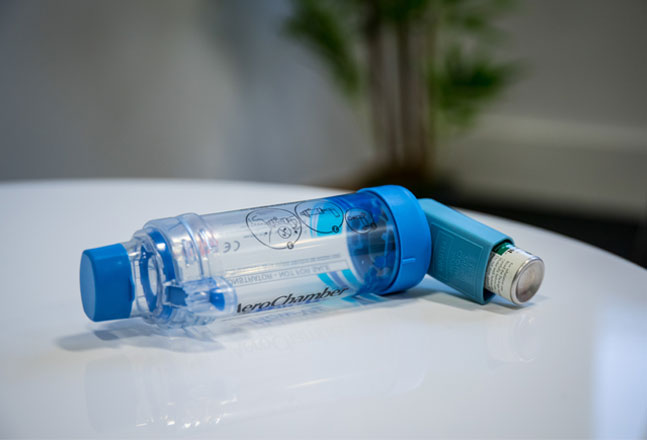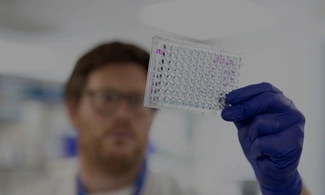What is a spacer?
Spacers are empty tubes that are usually made from plastic. You slot your inhaler into one end of the spacer and breathe the medicine in through the other end.
They help you get the best from your medicine if you use a metered dose inhaler (MDI).
If you’re using a dry powder Inhaler (DPI) or a breath-actuated inhaler (BAI), you won’t need to use a spacer. Speak to your GP, nurse, or pharmacist if you’re not sure which type of inhaler you’re using.

Types of spacers
Different brands of spacers fit different inhalers and are available on prescription including:
- Volumatic (these are slightly larger than other spacers)
- AeroChamber
- Able Spacer
- Space Chamber Plus
- A2A spacer
- EasyChamber
Some spacers have a mouthpiece, and some have a mask.
Speak to your GP, nurse or pharmacist about finding the right spacer for you. You can buy a spacer from your pharmacy without a prescription too.
What are the benefits of using a spacer?
Using a spacer with your metered dose inhaler (MDI) helps the right amount of medicine get to your lungs. Using a spacer will mean:
- you may waste less medicine
- you may reduce side effects from your preventer inhaler
- you may find it easier to take your medicine.
How to use a spacer
Your GP, nurse or pharmacist should show you how to use your inhaler and spacer properly. You can also check your technique at your annual asthma review.
There are two breathing techniques for adults and children to use with a spacer:
• Watch our video to help you do the ‘tidal or multiple breathing’ technique.
• Watch our video to help you do the ‘single breath and hold’ technique.
Both techniques work equally well. Multiple breathing may be prescribed to younger children as it’s easier to teach. Your GP can tell you if there’s a technique that will be better for you.
- You might find it easier to be in front of a mirror to check your head is at the correct angle.
- If you notice your spacer making a whistling sound, that means you’re breathing in too fast.
- If you need to take another dose, take the mouthpiece or mask away from your face, wait 30 seconds to a minute and shake the inhaler again. Then repeat the steps.
- Make sure you’re making a tight seal with your mouthpiece or mask so that no medicine can get out.
- Make sure you rinse your mouth out with water to help prevent side effects.
- Sit your child on your lap, either sideways or facing away from you.
- When you’ve finished, take the inhaler out of the spacer, and replace the caps on both.
- If your child has used an inhaler that contains steroids, make sure they rinse their mouth out with water to help prevent side effects.
- Watch our video on how to help your child use their inhaler and spacer.
Parents may find it easier to use a facemask with babies and younger children.
- If you have a baby or young toddler, sit them on your lap facing you so you can keep eye contact. With very young babies, you might find it best to tilt them back slightly.
- Cuddle your baby on your knee or cradle them in your arms. Gently tuck their arms out of the way with one hand if they try to knock the mask away.
- Be positive and smile! Your baby will be aware if you’re anxious.
- Gently stroke your baby’s cheek with the mask so they get used to how it feels.
- Reassure your child by pretending to take the medicine yourself or giving it to their favourite toy.
- You can distract your baby with music or a video if it helps.
Looking after your spacer
Hi I'm Leanne, a respiratory nurse specialist at Asthma and Lung UK. I'm going to tell you how to clean and store your spacer.
A spacer is a plastic tube that fits onto the mouthpiece of your inhaler. It helps you breathe the medicines into your lungs more easily. Spacers are used with pressurised metered dose inhalers or pMDIs. Keeping your spacer clean and in good condition helps make sure it works properly and you get the best from your medicines. When you first get a new spacer, clean it before you use it. After that you should usually clean your spacer once a month. [The Patient Information Leaflet (PIL) that comes with your spacer will tell you how often you should clean it. Ask a healthcare professional if you have any worries or questions.]
To clean your spacer, first take your spacer apart and gently clean it with warm water and a detergent, such as washing up liquid. Although most spacers are cleaned in the same way, check the instructions for your spacer. Only a small number of brands of spacer are dishwasher safe. Use warm water instead of boiling water, as boiling water may damage the spacer. Be careful not to scrub the inside of your spacer, as this can affect the way it works.
Some spacers need rinsing. With others, it's best to leave a soapy film, which prevents static. Static can make the medicine stick to the sides so it's hard to breathe in. If you're not sure, check the information leaflet that comes with your spacer.
Leave your spacer to air dry as this also helps to reduce static.
When it's completely dry put your spacer back together, ready for use.
Wipe the mouthpiece clean before you use it again.
When you're not using your spacer, storing it properly will keep it in good condition. Keep your spacer away from dust and liquids. Keep your spacer in a breathable bag such as a cotton or cloth bag, so it doesn't get scratched and so small objects don't get stuck inside it. Don't put your spacer in a plastic bag as this will cause it to build up static. Children could decorate a plastic-free medicine bag or a fabric pencil case so they're more likely to use it.
Most spacers need replacing every year, depending on how often you use it. Some spacers may need to be replaced sooner. Ask your GP or pharmacist if you're not sure. Spacers are not widely recycled, so you may need to dispose of it in the normal household waste, but check the information leaflet that comes with your spacer to find out how to dispose of it safely.
Priming means putting a dose of medicine on the inside of the spacer, to reduce static. This is so the medicine won't stick to the spacer. When you get a new spacer read the instructions to see if it needs priming before you first use it and how you should prime your spacer.
If you have any questions about looking after your spacer, speak to your doctor, nurse, or pharmacist. You can also call our helpline.
Replacing and disposing of your spacers
You should replace your spacer at least every year, especially if you use it daily, but some may need to be replaced sooner – ask your GP, nurse or pharmacist if you’re unsure.
Check the information leaflet that comes with your spacer to find out how to dispose of it. Spacers are not widely recycled so you may need to dispose your spacer in normal household waste.
If you’re using a spacer with rubber valves, replace it if the valves become stiff or are starting to crumble (become brittle).
Tips for cleaning your spacer
Clean your spacer regularly. The Patient Information Leaflet (PIL) that comes with your spacer will tell you how often you should clean it. Ask a healthcare professional if you have any worries or questions.
- Take your spacer apart and gently clean it with warm water and a detergent, such as washing-up liquid.
- Only a small number of brands of spacer are dishwasher safe, so check the instructions on the label.
- Use warm water instead of boiling water, as boiling water may damage the spacer.
- Be careful not to scrub the inside of your spacer as this might affect the way it works.
- Leave it to air-dry as this helps to reduce static (an electrical charge that builds up) and prevent the medicine sticking to the inside of the spacer.
- When it’s completely dry, put your spacer back together ready for use.
- Wipe the mouthpiece or mask clean before you use it again.
Storing your spacer
When you’re not using your spacer, storing it properly will keep it in good condition, helping you or your child to get the best from your medicine.
- Don’t put your spacer in a plastic bag as this will cause it to build up static and reduce the effect of the medicine.
- Keep your spacer away from dust and liquids so that you don’t breathe them in.
- If you carry your spacer in your bag, keep it in a plastic-free sealed purse or small bag so it doesn’t get scratched, and so small objects don’t get stuck inside it.
- You may find it useful to give your child a special plastic-free medicine bag or pencil case to keep their inhalers and spacer in. You could help them to decorate and personalise the case, so they are more likely to use it.
Inhaler choices
Did you know that managing your lung condition well could help you feel your best and help the environment? We’ve partnered with the NHS to support you to make changes, so that you can live better with your lung condition and help the environment at the same time.
Find out more about inhaler choices.

Get support
Call or email our helpline for support with your asthma. Get advice on medicines, symptoms or travelling with a lung condition. You can also find support through our groups.








